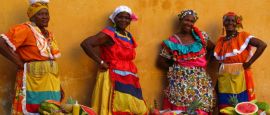Getting around Colombia
There is an excellent internal air network connecting major cities, including those in the Caribbean coastal area. There are also local helicopter flights. Flights between the mainland and the islands of San Andrés and Providencia operate from most major Colombian cities. The main domestic carriers are Avianca (www.avianca.com), Lan Colombia (www.lan.com), Copa Airlines (www.copaair.com) and Satena (www.satena.com).
Some areas have no road access, such as the Amazon River border town of Leticia, which must be accessed by air. Other areas have road routes but a flight is far more expedient and not too expensive; for example, Bogotá to Cartagena is a flight of 1 hour 25 minutes, but the bus journey takes 20 hours. Flights are cheaper when bought well in advance, but are still reasonably priced at short notice.
When booking domestic flights, it's often easiest to go into a travel company office – some domestic airlines don’t accept international credit cards online.
Departure tax for internal flights varies depending on your airline. Some include it in the ticket, others charge separately up to about US$10, but be aware that this situation is ever-changing.
The quality of the roads in Colombia varies massively. The Panamericana (Panamerican Highway) is mostly well paved, but when you start veering off the beaten track the roads get bumpier. Do not go for an exploratory drive into the jungle or areas deemed dangerous by your embassy. Expect landslides in the more mountainous regions during the rainy season (November to February). City driving is chaotic and dangerous.
There are several toll motorways throughout the country, though narrower and less well-maintained tracks become more frequent when travelling to smaller destinations.
The major international companies have offices and can arrange for vehicle pick-ups at the airport, but driving in cities is not recommended. Most companies require you to be 25 or over; some allow drivers over 21 but they are subject to a surcharge.
There are plenty of taxis in the big cities, and they are reasonably cheap. They are also considered fairly safe to hail in the street. You may get charged a bit more for being a tourist; in Bogotá, Cali and Medellín they have taximetros (meters), but in smaller places you have to negotiate the price. Drivers are generally not tipped.
Cycling is immensely popular in Colombia and there are all sorts of routes throughout the country, including cross-country missions, several day-long expeditions, mountain bike routes and city cycling. Check out www.mtbcolombia.com (in Spanish) for mountain bike routes and information.
Hostels and hotels in coastal cities and a few in Bogotá lend/hire bikes to guests (less so in mountain cities).
You can buy bicycles in Bogotá and other big cities, but they are generally not cheap. Try www.mercadolibre.com for second-hand bikes. Be safe when cycling – there are many trucks on the roads, and cycling off into the jungle isn’t a good idea.
There are many coach companies running buses to all towns and cities in Colombia. Among them are Bolivariano (tel: +57 1 424 9090; www.bolivariano.com.co), Expreso Brasilia (tel: 01800 051 8001, in Colombia only; www.expresobrasilia.com) and Copetran (tel: 01800 011 4164, in Colombia only; www.copetran.com.co).
Seat belts in the front seats are mandatory; car seats for children are also mandatory. Children under 10 cannot sit in the front seat. The speed limit is 45-60kph (28-37mph) in urban areas, 80kph (50mph) in rural areas and up to 120kph (75mph) on motorways, but few Colombians keep to these limits. It is forbidden to talk on a mobile phone while driving; again, however, most Colombians disregard this rule.
There are no national breakdown services in Colombia; ensure that your insurance covers you for breakdowns in case you need to be rescued by your car hire company.
An International Driving Permit is required; however, many car hire companies will accept a driving licence from your country. Insurance is compulsory.
Bogotá's bus service, TransMilenio (www.transmilenio.gov.co), is the most efficient way to travel round the capital. There are also buseta (shared taxis) which are not expensive and stop on demand. Medellín, Colombia's second largest city, has a metro train service and cable-car lines to hillside suburbs. Travelling on public transport in Colombia is safer than you might assume, but you should always exercise vigilance.
Although trains still carry freight, inter-city passenger services are virtually non-existent. A restored steam train, Turistren, runs from Bogotá to Zipaquirá and Cajicá (tel: +57 1 375 0557; www.turistren.com.co).
Cargo ships from Cartagena to San Andrés occasionally take passengers, but the trip takes several days. You can obtain information from the Maritima San Andrés office.
The Magdalena River is the main artery of Colombia. Some cargo boats take passengers, though this is a slow way to travel. Paddle steamers no longer run services up and down the river and hiring can be expensive.
From Leticia, on the Peruvian border, a number of operators run sightseeing tours and jungle expeditions up the Amazon. It's necessary to make enquiries locally, and wise to shop around before booking on any one trip.
Do you have any Feedback about this page?
© 2025 Columbus Travel Media Ltd. All rights reserved. No part of this site may be reproduced without our written permission, click here for information on Columbus Content Solutions.




 You know where
You know where